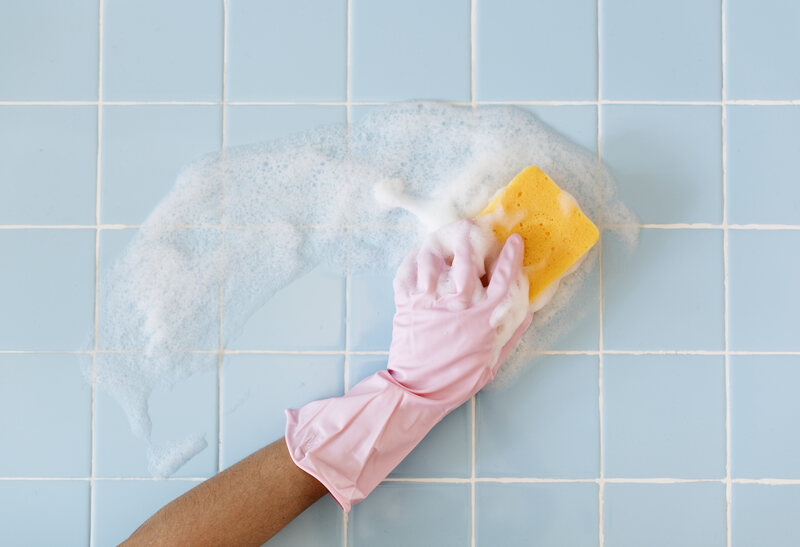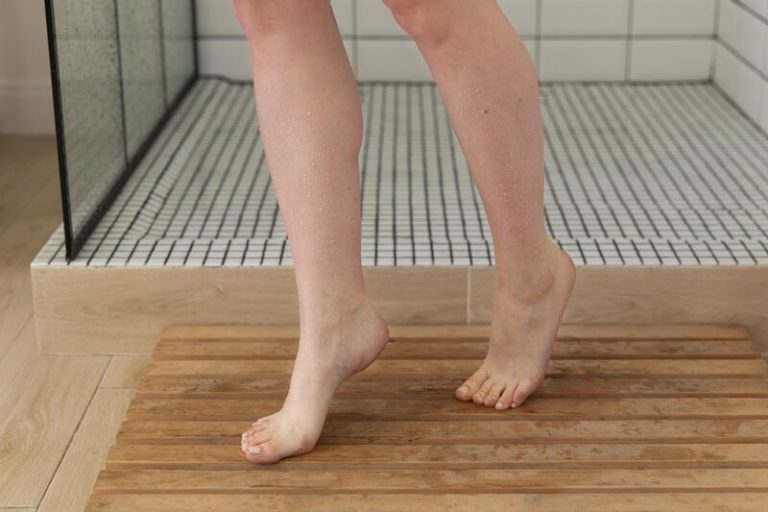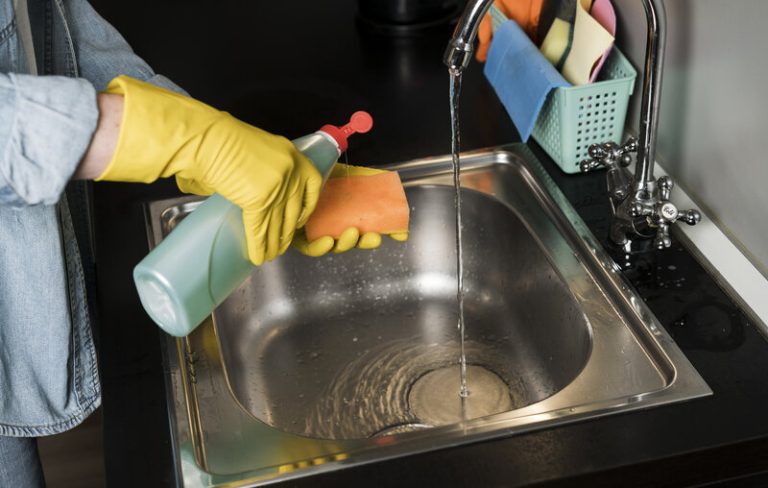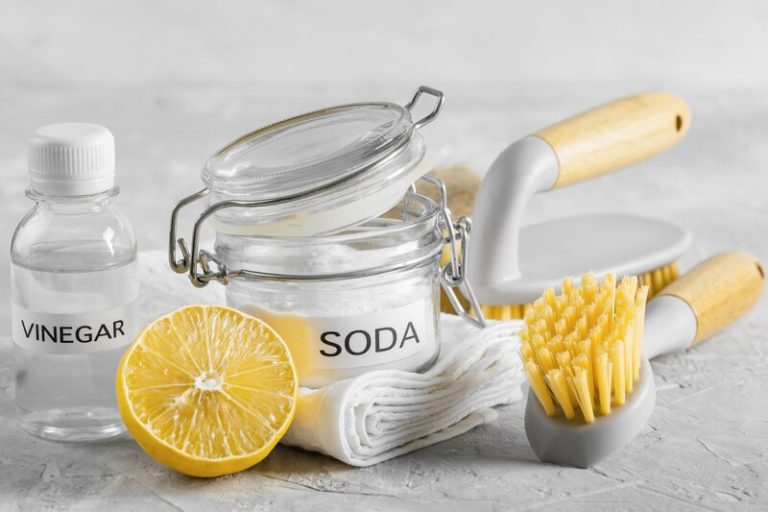Are you tired of looking at dirty and shabby bathroom walls? Therefore, cleaning bathroom walls is very important to maintain a healthy and aesthetic environment in your home.
In this article, we will discuss the importance of cleaning walls in the bathroom and products that can answer your curiosity of what do you clean bathroom walls with.
We will also provide a step-by-step guide on how to clean walls in the bathroom and disinfect your bathroom walls easily and effectively.
Get your cleaning supplies ready, and let’s make those walls sparkle with the easiest way to clean bathroom walls guide below.
The Importance of Cleaning Bathroom Walls
Cleaning bathroom walls is crucial for maintaining the overall hygiene and appearance of your home, as bathroom walls are often exposed to moisture and can become breeding grounds for mould and mildew, which can damage interior walls and potentially pose health risks, according to Sabrina Fierman of New York’s Little Elves.
What to Use to Clean Bathroom Walls?
Choosing the right cleaning products for bathroom walls is essential to effectively remove dirt and stains while preserving the integrity of the wall finishes, as recommended by experts.
a. All-Purpose Cleaner
An all-purpose cleaner is a versatile option that can effectively clean various types of walls without causing damage, making it a popular choice for maintaining bathroom cleanliness.
One of the key benefits of using an all-purpose cleaner is its ability to tackle different surfaces, from tiles to painted walls, with ease. The convenience of having a single product for multiple cleaning tasks saves time and effort.
When applying the cleaner to bathroom walls, remember to follow expert advice from Tamara Day, who suggests starting from the top and working your way down to prevent streaks and drips. Use a microfiber cloth or sponge to scrub gently, ensuring even coverage for a sparkling finish.
b. Vinegar Solution
A vinegar solution, particularly white vinegar, is a natural and effective cleaning method for bathroom walls, known for its ability to cut through grime and eliminate odours on household surfaces.
To prepare this cleaning solution, simply mix equal parts of white vinegar and water in a spray bottle. Shake well to ensure proper mixing. For tough stains or mould, you can use the solution undiluted.
When using the vinegar solution, apply it generously on the wall surface and let it sit for a few minutes to penetrate the dirt. Use a sponge or cloth to scrub the area, focusing on stubborn spots. The acidity in vinegar helps break down stains and grime without harsh chemicals.
c. Bleach Solution
Bleach is a powerful cleaning product that can be used to disinfect bathroom walls and remove stubborn stains, making it particularly effective in areas prone to mould and mildew.
It is crucial to use bleach safely to avoid any accidents or harmful chemical reactions. When working with bleach, always wear protective gloves and eye goggles to shield your skin and eyes from irritation.
Ensure proper ventilation by opening windows or turning on exhaust fans to prevent inhaling strong fumes. Dilute the bleach with water according to the manufacturer’s instructions, as using undiluted bleach can damage surfaces and increase health risks.
To clean bathroom walls effectively, apply the diluted bleach solution with a sponge or cloth, starting from the top and working downward. Leave the solution on the walls for a few minutes to allow it to disinfect and break down stains.
Rinse the walls thoroughly with clean water to remove any bleach residue. Wipe down the walls with a separate cloth soaked in plain water to ensure all bleach is removed. Allow the walls to air dry completely before using the bathroom again.
d. Baking Soda Paste
Bicarbonate of soda paste is an excellent mild cleaning solution for dealing with tough stains on bathroom walls without damaging the paint.
To create a bicarbonate of soda paste for cleaning walls, simply mix the bicarbonate of soda with water in a small bowl until it forms a paste-like consistency. Apply the paste to the stained areas of the wall using a clean cloth or sponge, then gently scrub in a circular motion. Let the paste sit for a few minutes to allow it to work its magic on the stains.
Due to the mild nature of the bicarbonate of soda, it effectively removes stains while being safe for most wall surfaces, including painted walls. The alkaline properties of bicarbonate of soda help to break down dirt and grime without causing any harm.
What Do You Use to Clean Bathroom Walls?
To efficiently clean bathroom walls, having the right tools is essential, including items like:
a. Sponge or Cloth
Using a sponge or cloth is a basic yet effective way to clean bathroom walls, allowing you to gently scrub away dirt and grime.
In terms of choosing the right tool for the job, consider the type of wall surface you are dealing with. For painted walls, a soft microfiber cloth is ideal to avoid scratching or damaging the paint. On the other hand, for tiled walls, a slightly abrasive sponge may be more effective in removing stubborn stains.
To make the cleaning process more efficient, start by dampening the sponge or cloth with warm water and a mild cleaning solution.
b. Scrub Brush
A scrubbing brush is particularly useful for scrubbing away stubborn stains and grime that cannot be removed with a sponge or cloth alone.
There are several types of scrubbing brushes available for various cleaning tasks. Stiff-bristled brushes are ideal for tougher stains on surfaces like tiles or grout, while soft-bristled brushes are more suitable for delicate surfaces such as wood or glass. For walls, a brush with medium bristles is often recommended to strike the right balance between abrasiveness and gentleness.
When scrubbing walls, it’s important to use the correct technique to avoid damaging the paint or surface. Start by wetting the brush bristles and applying a mild cleaning solution. Work in small sections, using gentle circular motions to lift dirt without scrubbing too hard. Rinse the brush frequently to prevent transferring dirt back onto the wall.
c. Microfiber Cloth
Microfibre cloths are ideal for gentle cleaning and dusting of bathroom walls, as their soft texture prevents scratches while effectively trapping dust and dirt.
These cloths are highly absorbent, making them perfect for wiping down wet surfaces and removing stains from walls without leaving streaks behind. In addition, the electrostatic properties of microfibre attract dust particles like a magnet, ensuring a thorough cleaning with minimal effort.
How to Clean Dirty Bathroom Walls?
Cleaning bathroom walls involves a series of steps to ensure they are thoroughly cleaned and free of dirt, stains, and grime, requiring the use of a suitable cleaning solution, proper scrubbing techniques, and thorough rinsing with warm water. Here are the explanations for the steps for washing bathroom walls.
a. Preparing the Walls
Before applying any cleaning solution, it’s important to prepare the walls by dusting them thoroughly, using a dust brush attachment to remove fingerprints, cobwebs, and loose dirt.
It might seem like a simple task, but dusting the walls plays a crucial role in ensuring that the cleaning process is effective and does not spread dirt around. Dust left on the walls can mix with the cleaning solution, creating streaks and making it harder to achieve a smooth finish.
b. Applying the Cleaning Solution
Once the walls are dust-free, apply a gentle cleaning solution, such as a mixture of liquid dish soap and water, to tackle stains and grime without damaging the paint.
Start by mixing a small amount of liquid dish soap with warm water in a bucket or spray bottle. Test this solution in an inconspicuous area of the wall to ensure it doesn’t cause any discolouration.
For tougher stains like grease or crayon marks, add a bit of baking soda to the cleaning solution for extra scrubbing power. When you begin scrubbing, use a soft sponge or microfiber cloth to avoid scratching the paint. Work in small sections to ensure thorough cleaning.
c. Scrubbing the Walls
Scrubbing the walls is necessary for removing stubborn stains that regular cleaning methods may not address, and a scrub brush or foam craft brush for targeted cleaning is also necessary.
When scrubbing walls, it’s important to use gentle but firm pressure to avoid damaging the paint or surface. For particularly tough stains, a mixture of vinegar and water can be effective in breaking down grime without harsh chemicals.
d. Rinsing and Drying the Walls
After scrubbing, it’s crucial to rinse the walls with clean, warm water to remove any remaining cleaning solution and dirt, followed by drying the walls thoroughly with a clean cloth.
Rinsing the walls plays a vital role in ensuring that no residue of cleaning chemicals or grime is left behind, which could cause long-term damage.
This step also helps to prevent streaking or discolouration on the walls, leaving them looking fresh and spotless.
Once rinsed, the walls should be dried promptly to avoid any excess water seeping into the surface and causing potential issues such as mould growth or peeling paint.
How to Disinfect Bathroom Walls?
Disinfecting bathroom walls is an important step to eradicate harmful bacteria and germs, using effective cleaning methods and products like:
a. Using a Disinfectant Cleaner
A disinfectant cleaner in spray form is convenient for quickly and effectively killing germs on bathroom walls and other household surfaces.
When selecting a disinfectant cleaner, it’s important to consider the specific surfaces you’ll be cleaning. Some cleaners are designed for particular surfaces like glass, while others are more versatile and can be used on multiple surfaces.
To ensure safety, always read the labels and follow the instructions carefully. It’s advisable to wear gloves and a mask to protect your skin and respiratory system from the chemicals. Remember to always test a small inconspicuous area before applying the cleaner to the entire surface.
When applying the disinfectant, make sure to spray it generously on the surface and let it sit for the recommended amount of time to effectively kill the germs. For maximum effectiveness, avoid wiping the surface immediately after spraying to allow the solution to work its magic.
b. Using a Bleach Solution
Using a bleach solution is a powerful way to disinfect bathroom walls and remove stubborn stains, ensuring that surfaces are both clean and sanitary.
First and foremost, be sure to gather the necessary supplies: bleach, water, gloves, goggles, and a mask to protect yourself from the strong fumes. It is crucial to always read the instructions on the bleach bottle for proper dilution ratios.
Next, mix the bleach solution in a well-ventilated area by adding the appropriate amount of bleach to water in a bucket. Use a sponge or cloth to apply the solution to the walls, starting from the top and working your way down.
Allow the solution to sit for at least 5-10 minutes to effectively kill germs and bacteria. Rinse the walls thoroughly with clean water to remove the bleach residue. Remember to wear protective gear throughout the entire process to prevent skin and eye irritation. Ventilate the bathroom well to dissipate any remaining fumes before re-entering the room.
What Is the Easy Way to Clean Bathroom Walls?
The simplest way to clean bathroom walls involves using a ready-to-use cleaning solution spray and a microfibre cloth, making the cleaning process quick and efficient with minimal effort. Here is how to clean bathroom walls easily that you can try:
a. Use a Cleaning Solution Spray
A cleaning solution spray is ideal for quickly addressing stains and dirt on bathroom walls and other household surfaces, allowing for easy and efficient cleaning.
To use the spray, simply shake the bottle well, then spray it directly onto the soiled area. Let it sit for a few minutes to penetrate the dirt before wiping it away with a clean cloth or sponge.
The convenience of a cleaning solution spray makes it a time-saving addition to your cleaning routine, as there’s no need for mixing solutions or rinsing after application.
b. Wipe Down the Walls with a Microfiber Cloth
Using a microfibre cloth to wipe down the walls ensures gentle cleaning without scratching the surface, effectively trapping dust and dirt.
Microfibre cloths are highly absorbent, making them ideal for removing stubborn stains and spills from walls. The unique fibres in these cloths attract dirt particles and hold onto them, preventing streaks and leaving the walls looking spotless. Microfibre cloths are also reusable and machine washable, providing a more eco-friendly cleaning option compared to disposable wipes.
To achieve the best results, dampen the cloth slightly with water or a mild cleaning solution before wiping the walls in gentle circular motions. Avoid using harsh chemicals that could damage the paint or finish on the walls.
What Is the Best Way to Clean Bathroom Walls?
The best thing to clean bathroom walls involves a systematic cleaning method that covers from top to bottom in sections, followed by thorough rinsing and drying to ensure the walls remain clean. Here’s a further explanation.
a. Start from the Top and Work Your Way Down
Starting from the top and working your way down is a highly effective cleaning method, as gravity helps in pulling the dirt downwards, making it easier to clean progressively.
This approach ensures that any dust or debris dislodged from higher surfaces is tackled before moving on to lower areas, preventing the need to re-clean already cleaned spaces. This method not only saves time but also leads to a more thorough cleaning as you focus on one area at a time, giving attention to details that might be missed in a rushed cleaning session.
To implement this strategy effectively, start by dusting ceiling corners, light fixtures, and shelves first. Then, move on to surfaces like countertops and tables before finishing with the floors.
b. Clean in Sections
Cleaning in sections ensures thoroughness and manageability, allowing you to focus on smaller areas and avoid missing spots.
One of the key advantages of sectional cleaning is the ability to break down a daunting task into smaller, more manageable parts. This approach not only makes the cleaning process less overwhelming but also ensures that every nook and cranny receives the attention it deserves.
In terms of cleaning walls, dividing the surface into sections can significantly enhance the efficiency and effectiveness of the task. By focusing on one section at a time, you can work more attentively and thoroughly, resulting in a cleaner overall finish.
To clean walls in sections, start by assessing the wall surface and determining the best way to divide it.
c. Rinse and Dry the Walls Thoroughly
Rinsing and drying the walls thoroughly after cleaning is vital to remove any residual cleaning solution and moisture, which helps prevent mould growth and keeps the walls in good condition.
After thoroughly scrubbing the walls with a suitable cleaning solution and a sponge or cloth, the next step is to rinse the surfaces with clean water.
Ensure that all traces of the cleaning solution are completely removed, as any residue left behind can attract dust and dirt, leading to a dingy appearance over time.
Drying the walls completely is equally crucial, as lingering moisture can create a breeding ground for harmful mould and mildew.
This is all you need to know about cleaning bathroom walls. Although their existence is often underestimated, it turns out that keeping them clean is so important.
Maintaining spotless bathroom walls not only enhances the overall hygiene of your home but also prevents the growth of mould and mildew, which can cause health issues and damage to your property.
Instead of tackling this demanding task yourself, entrust it to the professionals at TEKA Cleaning. Our residential cleaning services ensure your bathroom walls and other hard-to-reach areas receive the thorough and expert cleaning they need. With our advanced techniques and equipment, we provide a deep clean that you can rely on.
Don’t compromise on cleanliness and health. Book TEKA Cleaning’s residential cleaning service today to ensure your bathroom is hygienic and sparkling. Contact us now at 01233 751 544 to schedule your appointment and experience the superior cleaning services we offer.
Read also:











